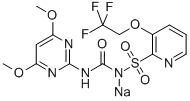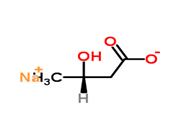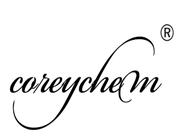Agricultural Uses
Trifloxysulfuron-sodium (CGA 362622) is a post-emergence herbicide commercialized by Syngenta in 2001 for use in all major cotton and sugarcane production areas.
In cotton, it is formulated as a WG 75 and can be applied post‐emergent at 5–7.5 g a.i. ha−1 in conventional or GM cotton but at higher rates of 10–15 g a.i. ha−1 if post-emergent directed. At the lower rates, the following weeds are controlled: Acanthospermum hispidum, A. artemisiifolia, B. pilosa, Senna obtusifolia, Cassia occidentalis, C. album, Euphorbia heterophylla, Ipomoea spp., Melochia corchorifolia, Mollugo vertillata, S. exaltata, Trianthema portulacastrum, and X. strumarium. With post-directed sprays and higher dosages, additional control is achieved of Ageratum conyzoides, Amaranthus hybridus, A. palmeri, C. esculentus, and Tridax procumbens. The application of trifloxysulfuron-sodium may be made after cotton (picker-type varieties only) has reached a minimum of five true leaves, with applications continuing until 60 days before harvest. Due to reduced crop tolerance, the product is not recommended as a post‐emergent over‐the‐top spray on stripper-type cotton varieties.
For cotton and sugarcane trifloxysulfuron-sodium is marketed under the trade name “Envoke®” as a straight product. In cotton, it is used in combination with prometryn as “Suprend®” and in sugarcane in combination with ametryn as “Krismat®.” In sugarcane, “Envoke” can be used for a maximum of three applications prespiking, post-emergence over the top, and/or post-emergence directed at a total rate of 78 g a.i. ha−1 per season. The product may be applied to sugarcane at a plant height of 45–60 cm up to 100 days before harvest. At a dose rate of 16 g a.i. ha−1, the following weeds are controlled with greater than 85% efficacy: Alternanthera philoxeroides, A. hispidum, Panicum adspersum, M. vertillata, X. strumarium, C. occidentalis, Gnaphalium pensylvanicum, Eupatorium cappilliforium, Desmodium tortuosum, T. portulacastrum, S. exaltata, Rottboellia cochinchinensis, C. album, Ipomoea spp., C. esculentus, C. rotundus, Amaranthus spp., A. artemisiifolia, M. corchorifolia, S. obtusifolia, Bidens bipinnata, Linaia canadensis, A. theophrasti, and E. heterophylla.

 China
China






